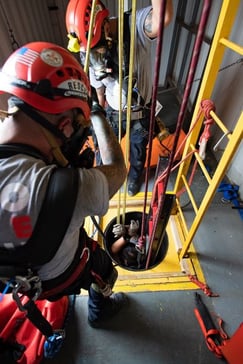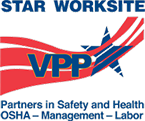Confined Space Types - Are All Your Bases Covered?
 Refineries, plants and manufacturing facilities have a wide range of permit-required confined spaces – some having only a few, while others may have hundreds. Some of these spaces may be relatively open and straightforward while others are congested and complex, or at height. With this in mind, are all your bases covered? Can your rescue team (or service) safely and effectively perform a rescue from these varying types of spaces? Or, are you left exposed? And, how can you be sure?
Refineries, plants and manufacturing facilities have a wide range of permit-required confined spaces – some having only a few, while others may have hundreds. Some of these spaces may be relatively open and straightforward while others are congested and complex, or at height. With this in mind, are all your bases covered? Can your rescue team (or service) safely and effectively perform a rescue from these varying types of spaces? Or, are you left exposed? And, how can you be sure?
Rescue Practice & Preplanning
With a large number of permit spaces on site, it would be impossible for a rescue team to practice in each and every one. Plus, in most cases, the spaces are operating, functioning units within the plant. Because of this, section (k) of 1910.146 allows practice from “representative” spaces. This is where the Roco Confined Space Types Chart can make the process easier.
Using OSHA guidelines for determining representative spaces, the Roco Types Chart is designed to assist employers and rescue teams plan for various types of permit spaces.
The chart allows you to categorize permit spaces into six (6) confined space types, which can then be used to prepare rescue plans, determine rescue requirements, conduct practice drills or evaluate a prospective rescue service.
First of all, it's important to note that employers are required by 1910.146 and 1926 Subpart AA to allow rescue teams the opportunity to practice and plan for the various types of confined spaces they may be required to respond. This is critical for the success of the rescue, particularly timeliness, as well as for the safety of the rescuers.
Classifying and Typing Your Spaces
So, get out your clipboard, tape measure, some sketch paper, and a flashlight (if safe to do so) in order to view as much of the interior of the space as you can. And, if you absolutely need to enter for typing and/or rescue preplanning purposes, be sure to do so using full permitting procedures. Gaining access to architectural or engineering drawings may also be helpful in determining the internal configuration when actual entry is not feasible. Armed with this information, it is time to “type” the spaces in your response area using the Roco Confined Space Types Chart.

Over the decades, we’ve seen just about every type of confined space configuration out there. And, while there may be hundreds of permit spaces on site, most of them will fit into one of these six types and require the same (or similar) rescue plan. Of course, there are always unique situations in addition to physical characteristics, such as space-specific hazards or specialized PPE requirements, but this chart can be a valuable tool in the planning and preparation for confined space rescue operations.
We’ve also learned that it is imperative to understand the physical limitations of space access and internal configuration as well as how this affects equipment and technique choices for the rescue team. Referring to the Roco Types Chart and practicing simulated rescues from the relevant types of spaces will help identify these limitations in a controlled setting instead of during the heat of an emergency.
We can all agree that during an emergency is NOT the time to learn that your backboard or litter will not fit through the portal once the patient is packaged.
Six General Types
On the Roco Types Chart, you will note that there are six (6) general types identified, which are based on portal opening size and position of portal. Types 1 and 2 are “side” entries; Types 3 and 4 are “top” entries; and Types 5 and 6 are “bottom” entries. There are two types of each based on portal size, which is significant for rescue purposes. Openings greater than 24-inches will allow packaged patients on rigid litters or rescuers using SCBA to negotiate the opening; whereas, openings 24-inches or less will not.
Portals less than 24-inches will require a higher level of expertise and different packaging and patient movement techniques.
Once the various types have been determined, pay particular attention to spaces identified as Types 1, 3, or 5. Again, these spaces have the most restrictive portals (24-inches or less) and are considered “worst case” regarding entry and escape in terms of portal size. This is very important because it will greatly influence the patient packaging equipment and rescuer PPE that can be used in the space.
Accessibility and Internal Configuration
In addition to the “type” of the space based on portal size and location, another key consideration is accessibility or “elevation” of the portal. While the rescue service may practice rescues from Top, Side and Bottom portals – being at ground level is very different from a portal that’s at 100-ft. Here’s where high angle or elevated rescue techniques are normally required for getting the patient lowered safely to ground level.
Lastly, the internal configuration of a space must be carefully considered for rescue purposes. This will be discussed more in the following section on Appendix F.
Remember, rescue practice from a representative space needs to be a “true” representation of the kind of rescue that may be required in an emergency.
1910.146 Appendix F – Representative Spaces
In Appendix F, OSHA offers guidelines for determining Representative Spaces for Rescue Practice. OSHA adds that “teams may practice in representative spaces that are ‘worst case’ or most restrictive with respect to internal configuration, elevation, and portal size.” These characteristics, according to OSHA, should be considered when deciding whether a space is truly representative of an actual permit space.
(1) Internal Configuration

What’s inside the space? If the interior is congested with utilities or other structural components that may hinder movement or the ability to efficiently package a patient, it must be addressed in training. For example, will the use of entrant rescuer retrieval lines be feasible? After one or two 90-degree turns around corners or around structural members, the ability to provide external retrieval of the entrant rescuer is probably forfeited. For vertical rescue, if there are offset platforms or passageways, there may be a need for directional pulleys or intermediate haul systems that are operated inside the space.
What about rescues while on emergency breathing air? If the internal configuration is so congested that the time required to complete patient packaging exceeds the duration of a backpack SCBA, then the team should consider using SAR. Will the internal configuration hinder or prevent visual monitoring and communications with the entrant rescuers? If so, it may be advisable to use an additional authorized rescuer as an “internal hole watch” to provide a communication link between the rescuers and personnel outside the space.
What if the internal configuration is such that complete patient packaging is not possible inside the space? This may dictate a “load-and-go” type rescue that provides minimal patient packaging while providing as much stabilization as feasible through the use of extrication-type short spine boards as an example.
(2) Elevation
If the portal is 4 feet or greater above grade, the rescue team must be capable of providing an effective and safe high angle lower of the victim; and, if needed, an attendant rescuer. This may require additional training and equipment. For these situations, it is important to identify high-point anchors that may be suitable for use, or plan for portable high-point anchors, such as a “man lift” or some other device.
(3) Portal Size

Here again, the magic number is 24 inches or less for round portals or in the smallest dimension for non-round portals. It is a common mistake for a rescue team to “test drive” their 22-to-23-inch wide litter or backboard on a 24-inch portal without a victim loaded and discover that it barely fits. However, the problem arises when a victim is loaded onto the litter. The only way the litter or backboard will fit is at the “equator” of the round portal. This will most likely not leave enough room between the rigid litter or backboard and the victim’s chest, except for our more petite victims.
For rescuers, it is already difficult to negotiate a portal while wearing a backpack SCBA. For portals of 24 inches or less, it’s nearly impossible. If the backpack SCBA will not fit, it is time to consider an airline respirator and emergency escape harness/bottle instead. Warning: Do NOT under any circumstances remove your backpack SCBA in order gain access to a confined space through a restricted portal or passageway. It is just too easy for a mask to become displaced.
(4) Space Access – Horizontal vs. Vertical
Most rescuers regard horizontal retrievals as easier than vertical. However, this is not always the case. If there are floor projections, pipe work or other utilities, even just a grated floor surface, it may create an incredible amount of friction or an absolute impediment to the horizontal movement of an inert victim. In this case, the entrant rescuers may have to rely on old-fashioned arm and leg strength to maneuver the victim.
Putting the Roco Types Chart into Practice
The Roco CS Types Chart can assist by first providing a way to classify and type your different kinds of spaces. This information can then be used to design training/practice drills as well as annual performance evaluations to make sure your rescue service is capable of rescue from the varying representative spaces onsite. Of course, this applies whether you use an in-house rescue team, a contracted rescue service, or a local off-site response team. Otherwise, how do you know if you truly have your bases covered? Don’t take that chance. If an incident occurs and the rescue personnel you are depending on are not capable of safely performing a rescue, your company could be culpable.
In section (k), OSHA requires employers to evaluate the prospective rescue service to determine proficiency in terms of rescue-related tasks and proper equipment.
If you need assistance with confined space typing or rescue preplan preparation, please contact us at info@rocorescue.com or 800-647-7626.
Request your Confined Space Types Chart & Compliance Guide.




